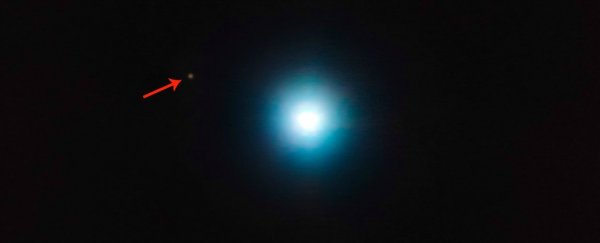Astronomers have managed to capture an amazingly clear image of CVSO 30c - a potential exoplanet orbiting a distant star named CVSO 30, that lies some 1,200 light-years away.
Besides being breathtaking to look at, researchers are extra excited about the new photo, because it could mean that CVSO 30 actually has two planets orbiting it instead of just one.
Follow-up observations and analysis will be needed to confirm CVSO 30c as a true exoplanet, but if verified, this would be the first star system to host both a close-in exoplanet and a far-out exoplanet.
Four years ago, astronomers found a different exoplanet - named CVSO 30b, which is too faint to see in this photo - orbiting the star, thanks to the transit method. This involves detecting planets by looking at how a star's light flickers when something passes in front of it.
Unlike CVSO 30b, which orbits remarkably close to CVSO 30 at a distance of roughly 1.2 million kilometres (744,000 miles), and takes only 11 hours to complete one lap, CVSO 30c is way further out, at a distance of 98,730,000,000,000 kilometres (61,347,977,809,592 miles) or 660 AU - a unit that's equivalent to the distance between Earth and the Sun.
In other words, CVSO 30c is 660 times further from its star than we are from our Sun.
At this distance, it takes CVSO 30c about 27,000 years to orbit CVSO 30 just once. And because this distance is so immense, the team isn't completely sure that the exoplanet is even part of the star system. If it is, it was probably shot out that far after interacting with the other exoplanet, though at this point there is no evidence to support either hypothesis.
"If it is confirmed that CVSO 30c orbits CVSO 30, this would be the first star system to host both a close-in exoplanet detected by the transit method and a far-out exoplanet detected by direct imaging," said ESO officials.
"Astronomers are still exploring how such an exotic system came to form in such a short timeframe, as the star is only 2.5 million years old; it is possible that the two planets interacted at some point in the past, scattering off one another and settling in their current extreme orbits," they continued.
While it will likely take some time for researchers to tease out more details about CVSO 30c, the image is certainly proof that astronomers - and the telescopes they work with - are getting insanely good at snapping pictures of faraway worlds.
And let's take a second to truly understand just how far away from us CVSO 30 really is. According to Mike Wall from Space.com, who crunched the numbers, CVSO 30 is roughly 280 times further away from us than Alpha Centauri, everyone's favourite neighbouring star system.
This puts the total distance between us and CVSO 30 at 11 quadrillion kilometres (7 quadrillion miles).
And yet we still managed to take this incredible image:
 ESO
ESO
To take an image of a planet that's so far away, ESO researchers working with the Very Large Telescope (VLT) in Chile teamed up with astronomers at the Keck Observatory in Hawaii and the Calar Alto Observatory in Spain.
Combining the might of all three of these ridiculously powerful observatories gave astronomers the tools they needed to capture the remarkable 'direct image'.
So far, there has been no word on when independent researchers will verify that the CVSO 30c is actually a planet or not. Until then, at least we have this awesome picture to keep us entertained.
The findings have been approved for publication in Astronomy & Astrophysics, but you can read them for free on ESO's site.
